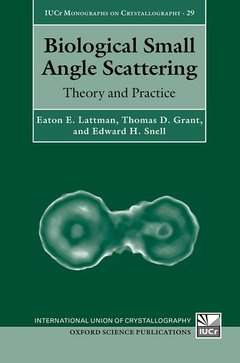Biological Small Angle Scattering Theory and Practice International Union of Crystallography Monographs on Crystallography Series, Vol. 29
Langue : Anglais
Auteurs : Lattman Eaton E., Grant Thomas D., Snell Edward H.

Small angle solution scattering (SAS) is increasingly being applied to biological problems. It is a complementary technique that, when applied in appropriate circumstances with carefully structured questions, can provide unique information not available from other techniques. While small angle solution scattering has been around for some time, a confluence of recent developments has dramatically enhanced its power. Intense third generation X-ray sources, low noise detectors, development of new algorithms and the computational power to take advantage of these have all matured, and use of free-electron x-ray laser sources is on the horizon. Whole new classes of experiments and analyses have been created as a result. These include the generation of molecular envelopes, the ability to do time-resolved studies, and the ability to account for structural changes using modelling based on the SAS data. The technical improvements have also reduced the amount of time and material needed to carry out an experiment. Beamtime at synchrotron sources is in demand, workshops on the subject are popular and researchers adopting the technique as part of their repertoire are growing. With these in mind, this book was written to guide structural biologists who may wish to adopt the technique, understand its strengths and weaknesses or just have a general interest in its potential.
Eaton Lattman received a BA degree from Harvard College in Chemistry and Physics, and a PhD degree from the Johns Hopkins University in Biophysics. He went on to spend many years at Johns Hopkins, rising through the ranks to become Professor, Departmental Chair, and Dean of Research and Graduate Education. He is currently Professor of Structural Biology in the School of Medicine and Biomedical Sciences, University at Buffalo, SUNY. He has published many papers in the area of structural biology, including a number on methods development. Thomas Grant received a B.S. degree from the University at Buffalo in Mathematical Physics and a PhD from the University at Buffalo in Structural Biology. After a post-doc at the Hauptman-Woodward Institute, he became a Staff Scientist as part of the NSF Science and Technology Center known as BioXFEL through the University at Buffalo. Edward Snell is President and Chief Executive Officer at the Hauptman-Woodward Medical Research Institute in Buffalo, NY, and Bioinnovations Professor at the University of Buffalo, SUNY.
Date de parution : 07-2018
Ouvrage de 284 p.
16.4x23.7 cm
Thèmes de Biological Small Angle Scattering :
© 2024 LAVOISIER S.A.S.


